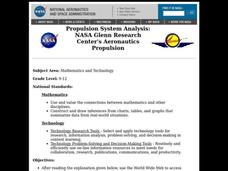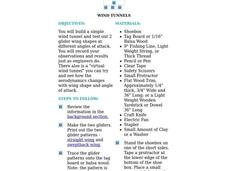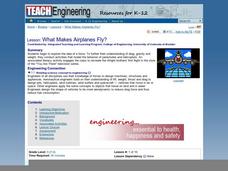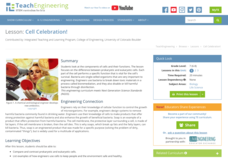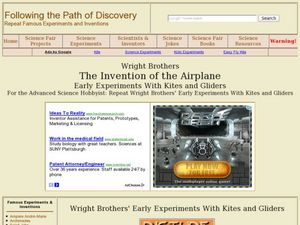Teach Engineering
Can You Take the Pressure?
Do not let the pressure get to you. The first lesson in a unit of 22 introduces the concept of air pressure. Using background knowledge, the resource gives teachers the information they need to discuss how people measure air pressure and...
Curated OER
Wind Tunnels
Young scholars build a simple wind tunnel and test out 2 glider wing shapes at different angles of attack. They record results and their observations just as engineers do.
Curated OER
The Shapes of Flight
Learners explore interaction between mathematics, science, and technology as they look at process of researching, developing, testing, and evaluating airplane design. They calculate glide ratio for model paper airplane by using data...
Curated OER
Aeronautics - Propeller experiments - Experiment 5 - Level 1
Students participate in propeller experiments. They research the purpose of the propeller and its functions. Students create and experiment with blades and straws to produce a breeze.
Curated OER
Aeronautics Propulsion
Students use the World Wide Web to access additional information needed to complete the activities on the forces on an airplane, the function of the stabilizer, and the calculation of Mach speed, temperature, pressure, and thrust.
Curated OER
Women in Space
Students read biographies of women who have made contributions to field of aerospace and aeronautics, choose one woman to research, and present their findings to classmates in form of essay, play, poster, or presentation.
Curated OER
Lindbergh Flies Again
Young scholars research to find the location of the flight of Charles Lindbergh, and interpret its significance. They identify and analyze the changes in aeronautic technology since 1927. The instructional activity lists several...
Curated OER
Sea to Sky
Students investigate the Earth's major landforms and how they occur, and how engineers apply this knowledge for the design of transportation systems, mining, and measuring natural hazards. They listen to a teacher-led lecture, match...
Curated OER
Geometry of Exploration: Eyes Over Mars
Learners research how engineers and scientists generate linear and angular measurements with geometry to survey the Earth and Mars. They assess how geometric shapes affect navigation. A surveyor comes to the classroom and explains how he...
Curated OER
Wind Tunnels
Pupils build a simple wind tunnel and test out 2 glider wing shapes at different angles of attack. They record their observations and results just as engineers do. There also is a "virtual wind tunnel" they can try to test aerodynamic...
Curated OER
What Makes Airplanes Fly?
Students examine force and conduct activities that model parachutes and helicopters. In this airplanes lesson students identify the forces that make airplanes fly higher and land.
Curated OER
Keep Your Bubbles Up
Students investigate design and the correct use of technology. In this chemistry activity, students investigate the Bernoulli Principle using hands on bubble making. They link the principle that keeps the bubble aloft to the BP principle.
Teach Engineering
Cell Celebration!
Are you eukaryotic? (Answer: Yes.) The first of six installments in the Cells units teaches pupils about the similarities and differences of prokaryotes and eukaryotes. It also covers the functions of various cell components in both...
NASA
Suit Yourself: Fitted for Space
If he keeps this up, will he have enough air? After watching a video about spacewalks, groups of four brainstorm aspects of spacesuit design and present it to the rest of the class. Groups create mathematical models of oxygen use for two...
NASA
Space Shuttle Ascent: Altitude vs. Time
How long did it take to get to that altitude? Using a Google Earth file, groups explore a space shuttle launch. Using a calculator, groups determine the function that models the altitude/time data from an actual launch. With the model in...
NASA
Lost in Space: Bone Density
If you don't use it, you lose it. Groups work together to compare bone loss on Earth as opposed to bone loss in space. They determine the equations that model bone loss and make calculations to determine the amount of bone loss for...
Curated OER
Hanging Around
Learners explore weight by building a spring scale and observing how it responds to objects with different masses. Each team of students can make their own spring scale by following steps which are specifically outlined in the plan. As...
Curated OER
From Future Flight to Past Flight
Students complete a set of CD-ROM's to introduce them to the flight program at NASA. In groups, they research a topic related to flight and put their information on a CD-ROM. To end the lesson, they share their material with other...
Curated OER
The Invention of the Airplane
Students explore the history of the airplane and the Wright brothers. In this aviation lesson students examine the Wright brothers stories and kites.
Curated OER
Our Amazing, Powerful Sun
Middle schoolers examine where energy comes from and how it can be used. In this solar energy lesson students explore different aspects of the sun.
Curated OER
Life on the Moon
Pupils study the physical properties of the Moon. In this life on the moon lesson students describe the ways life on the Moon would be different than on Earth.
NASA
Space Vectors
How do you determine the position coordinates of objects in space? Using the provided worksheet, class members determine the location of the space shuttle based upon its spherical coordinates from the Dryden Flight Research Center.
Curated OER
Gingerbread Spacecraft
Students explore the different parts of the Cassini spacecraft. In this space science lesson, students create a model of the spacecraft using food products. They compare and contrast their model with the real one and evaluate its...
Curated OER
Strange New Planet
Students simulate different spacecraft missions using materials provided. In this space science lesson, students observe and record a planetary model's features from a distance. They relate this activity to scientists' space exploration...






